ECONOMICS FOR BUSINESS 7 7 Economics for Business Name of the University Course ID
VerifiedAdded on 2021/06/16
|8
|1472
|104
AI Summary
Running Head: ECONOMICS FOR BUSINESS ECONOMICS FOR BUSINESS 7 7 Economics for Business Name of the Student Name of the University Brunei Course ID Introduction 2 Summary of the article 2 Evaluation of the article 3 Recommendation 5 Conclusion 5 References 7 Introduction Agriculture contributing nearly 12 percent of nation’s GDP is one of the main pillars for Australian economy. A report published by banking experts of ANZ reflects the fact that the farm export of Australia in 10 ASEAN market has a prospect of growth in coming years.
Contribute Materials
Your contribution can guide someone’s learning journey. Share your
documents today.
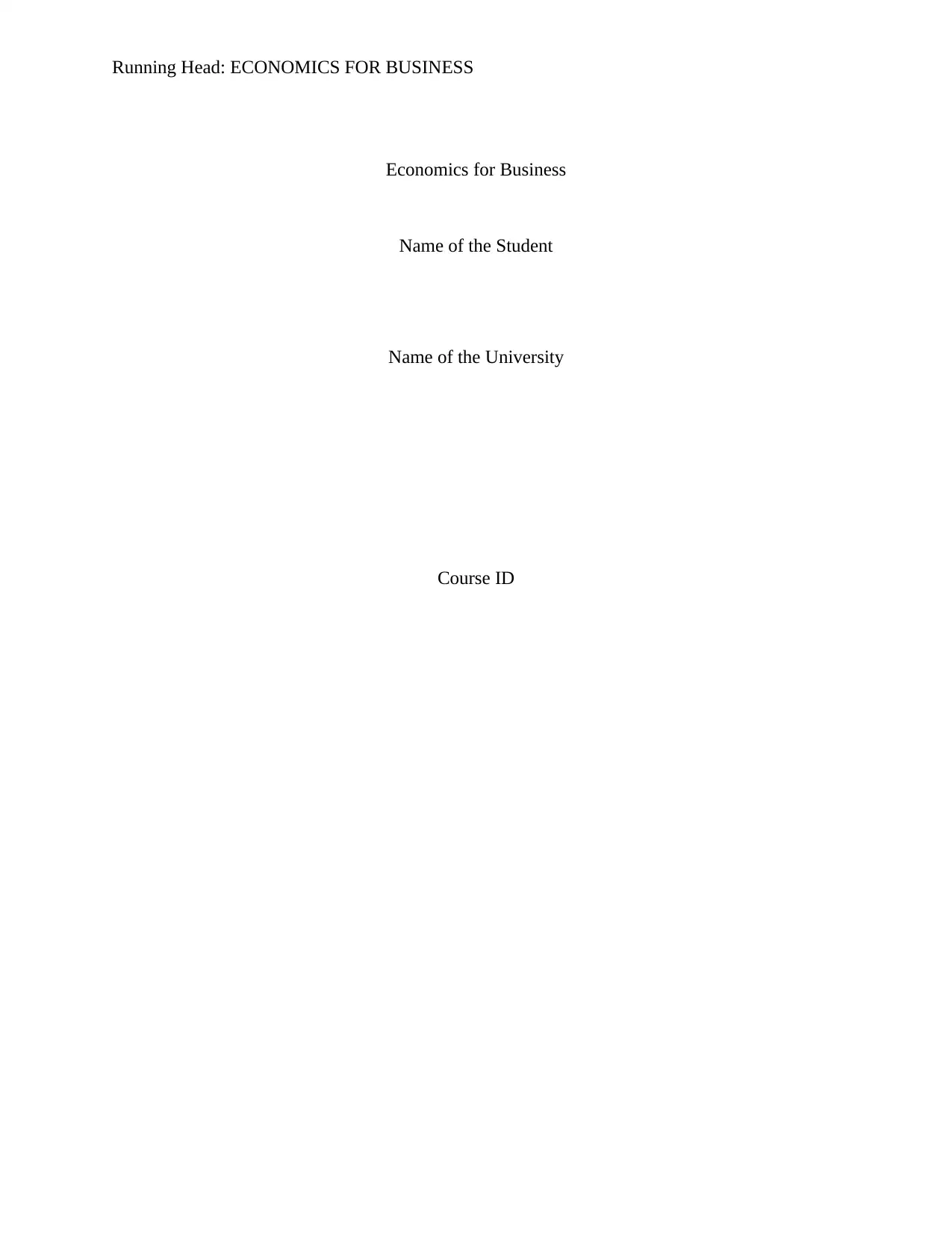
Running Head: ECONOMICS FOR BUSINESS
Economics for Business
Name of the Student
Name of the University
Course ID
Economics for Business
Name of the Student
Name of the University
Course ID
Secure Best Marks with AI Grader
Need help grading? Try our AI Grader for instant feedback on your assignments.
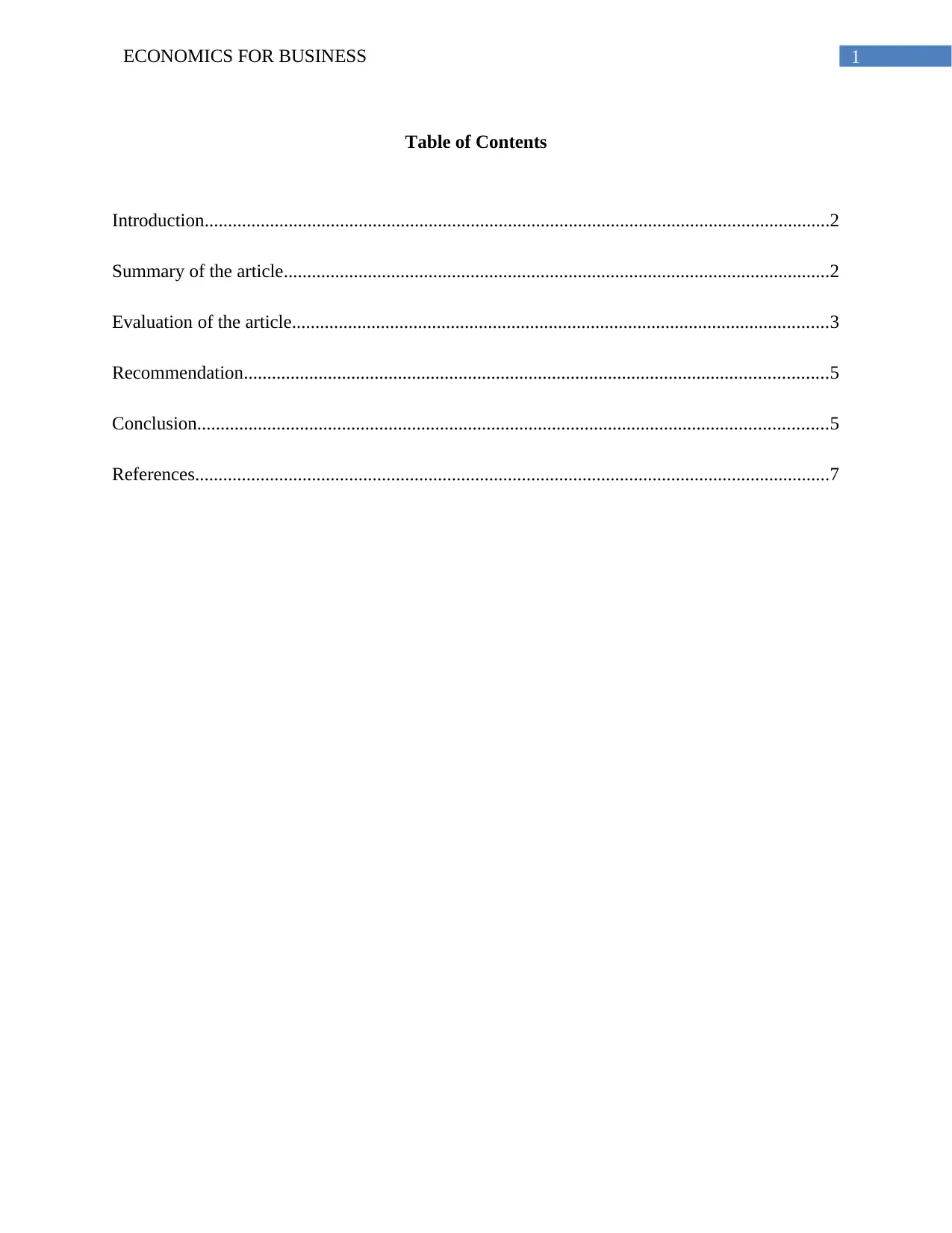
1ECONOMICS FOR BUSINESS
Table of Contents
Introduction......................................................................................................................................2
Summary of the article.....................................................................................................................2
Evaluation of the article...................................................................................................................3
Recommendation.............................................................................................................................5
Conclusion.......................................................................................................................................5
References........................................................................................................................................7
Table of Contents
Introduction......................................................................................................................................2
Summary of the article.....................................................................................................................2
Evaluation of the article...................................................................................................................3
Recommendation.............................................................................................................................5
Conclusion.......................................................................................................................................5
References........................................................................................................................................7
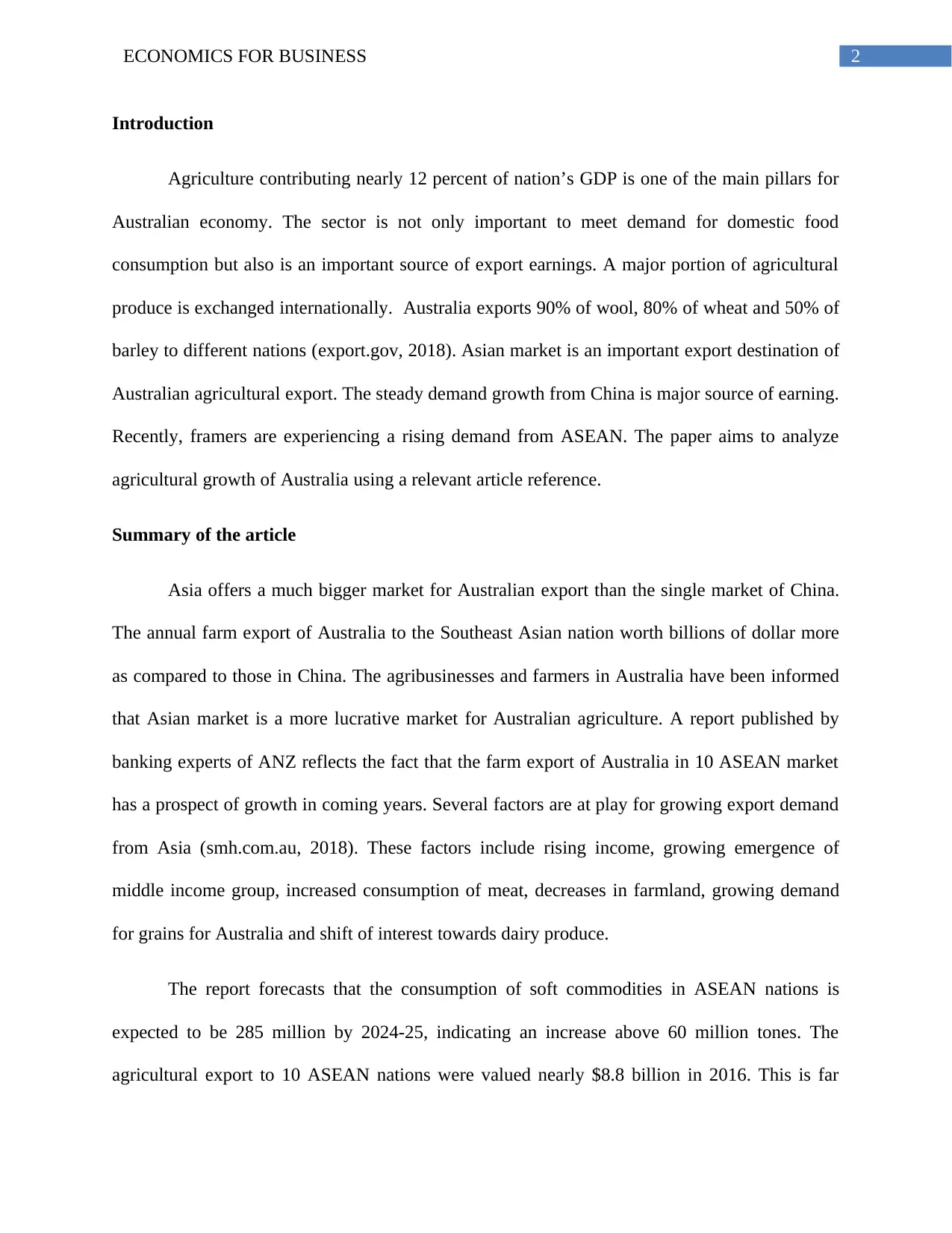
2ECONOMICS FOR BUSINESS
Introduction
Agriculture contributing nearly 12 percent of nation’s GDP is one of the main pillars for
Australian economy. The sector is not only important to meet demand for domestic food
consumption but also is an important source of export earnings. A major portion of agricultural
produce is exchanged internationally. Australia exports 90% of wool, 80% of wheat and 50% of
barley to different nations (export.gov, 2018). Asian market is an important export destination of
Australian agricultural export. The steady demand growth from China is major source of earning.
Recently, framers are experiencing a rising demand from ASEAN. The paper aims to analyze
agricultural growth of Australia using a relevant article reference.
Summary of the article
Asia offers a much bigger market for Australian export than the single market of China.
The annual farm export of Australia to the Southeast Asian nation worth billions of dollar more
as compared to those in China. The agribusinesses and farmers in Australia have been informed
that Asian market is a more lucrative market for Australian agriculture. A report published by
banking experts of ANZ reflects the fact that the farm export of Australia in 10 ASEAN market
has a prospect of growth in coming years. Several factors are at play for growing export demand
from Asia (smh.com.au, 2018). These factors include rising income, growing emergence of
middle income group, increased consumption of meat, decreases in farmland, growing demand
for grains for Australia and shift of interest towards dairy produce.
The report forecasts that the consumption of soft commodities in ASEAN nations is
expected to be 285 million by 2024-25, indicating an increase above 60 million tones. The
agricultural export to 10 ASEAN nations were valued nearly $8.8 billion in 2016. This is far
Introduction
Agriculture contributing nearly 12 percent of nation’s GDP is one of the main pillars for
Australian economy. The sector is not only important to meet demand for domestic food
consumption but also is an important source of export earnings. A major portion of agricultural
produce is exchanged internationally. Australia exports 90% of wool, 80% of wheat and 50% of
barley to different nations (export.gov, 2018). Asian market is an important export destination of
Australian agricultural export. The steady demand growth from China is major source of earning.
Recently, framers are experiencing a rising demand from ASEAN. The paper aims to analyze
agricultural growth of Australia using a relevant article reference.
Summary of the article
Asia offers a much bigger market for Australian export than the single market of China.
The annual farm export of Australia to the Southeast Asian nation worth billions of dollar more
as compared to those in China. The agribusinesses and farmers in Australia have been informed
that Asian market is a more lucrative market for Australian agriculture. A report published by
banking experts of ANZ reflects the fact that the farm export of Australia in 10 ASEAN market
has a prospect of growth in coming years. Several factors are at play for growing export demand
from Asia (smh.com.au, 2018). These factors include rising income, growing emergence of
middle income group, increased consumption of meat, decreases in farmland, growing demand
for grains for Australia and shift of interest towards dairy produce.
The report forecasts that the consumption of soft commodities in ASEAN nations is
expected to be 285 million by 2024-25, indicating an increase above 60 million tones. The
agricultural export to 10 ASEAN nations were valued nearly $8.8 billion in 2016. This is far
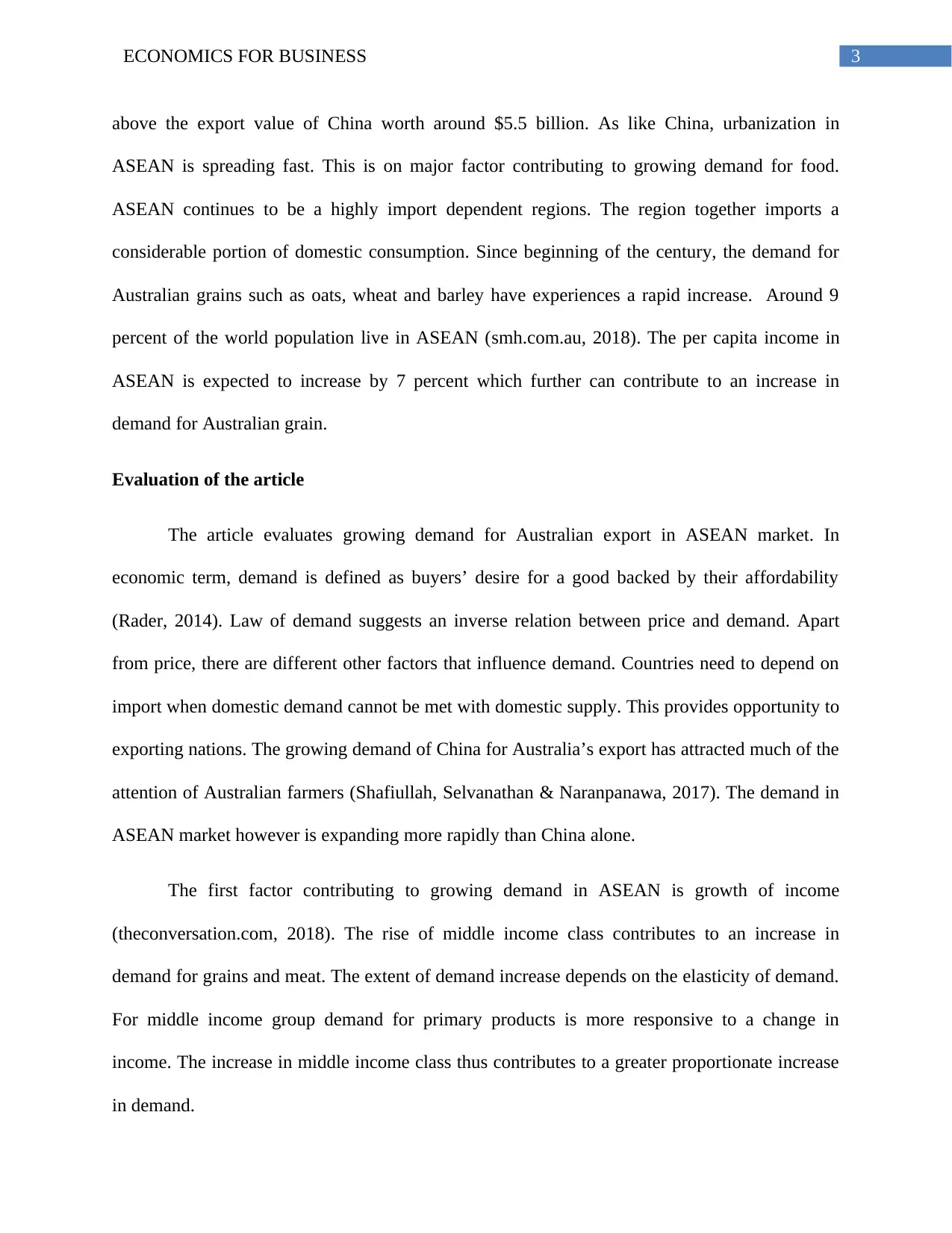
3ECONOMICS FOR BUSINESS
above the export value of China worth around $5.5 billion. As like China, urbanization in
ASEAN is spreading fast. This is on major factor contributing to growing demand for food.
ASEAN continues to be a highly import dependent regions. The region together imports a
considerable portion of domestic consumption. Since beginning of the century, the demand for
Australian grains such as oats, wheat and barley have experiences a rapid increase. Around 9
percent of the world population live in ASEAN (smh.com.au, 2018). The per capita income in
ASEAN is expected to increase by 7 percent which further can contribute to an increase in
demand for Australian grain.
Evaluation of the article
The article evaluates growing demand for Australian export in ASEAN market. In
economic term, demand is defined as buyers’ desire for a good backed by their affordability
(Rader, 2014). Law of demand suggests an inverse relation between price and demand. Apart
from price, there are different other factors that influence demand. Countries need to depend on
import when domestic demand cannot be met with domestic supply. This provides opportunity to
exporting nations. The growing demand of China for Australia’s export has attracted much of the
attention of Australian farmers (Shafiullah, Selvanathan & Naranpanawa, 2017). The demand in
ASEAN market however is expanding more rapidly than China alone.
The first factor contributing to growing demand in ASEAN is growth of income
(theconversation.com, 2018). The rise of middle income class contributes to an increase in
demand for grains and meat. The extent of demand increase depends on the elasticity of demand.
For middle income group demand for primary products is more responsive to a change in
income. The increase in middle income class thus contributes to a greater proportionate increase
in demand.
above the export value of China worth around $5.5 billion. As like China, urbanization in
ASEAN is spreading fast. This is on major factor contributing to growing demand for food.
ASEAN continues to be a highly import dependent regions. The region together imports a
considerable portion of domestic consumption. Since beginning of the century, the demand for
Australian grains such as oats, wheat and barley have experiences a rapid increase. Around 9
percent of the world population live in ASEAN (smh.com.au, 2018). The per capita income in
ASEAN is expected to increase by 7 percent which further can contribute to an increase in
demand for Australian grain.
Evaluation of the article
The article evaluates growing demand for Australian export in ASEAN market. In
economic term, demand is defined as buyers’ desire for a good backed by their affordability
(Rader, 2014). Law of demand suggests an inverse relation between price and demand. Apart
from price, there are different other factors that influence demand. Countries need to depend on
import when domestic demand cannot be met with domestic supply. This provides opportunity to
exporting nations. The growing demand of China for Australia’s export has attracted much of the
attention of Australian farmers (Shafiullah, Selvanathan & Naranpanawa, 2017). The demand in
ASEAN market however is expanding more rapidly than China alone.
The first factor contributing to growing demand in ASEAN is growth of income
(theconversation.com, 2018). The rise of middle income class contributes to an increase in
demand for grains and meat. The extent of demand increase depends on the elasticity of demand.
For middle income group demand for primary products is more responsive to a change in
income. The increase in middle income class thus contributes to a greater proportionate increase
in demand.
Secure Best Marks with AI Grader
Need help grading? Try our AI Grader for instant feedback on your assignments.
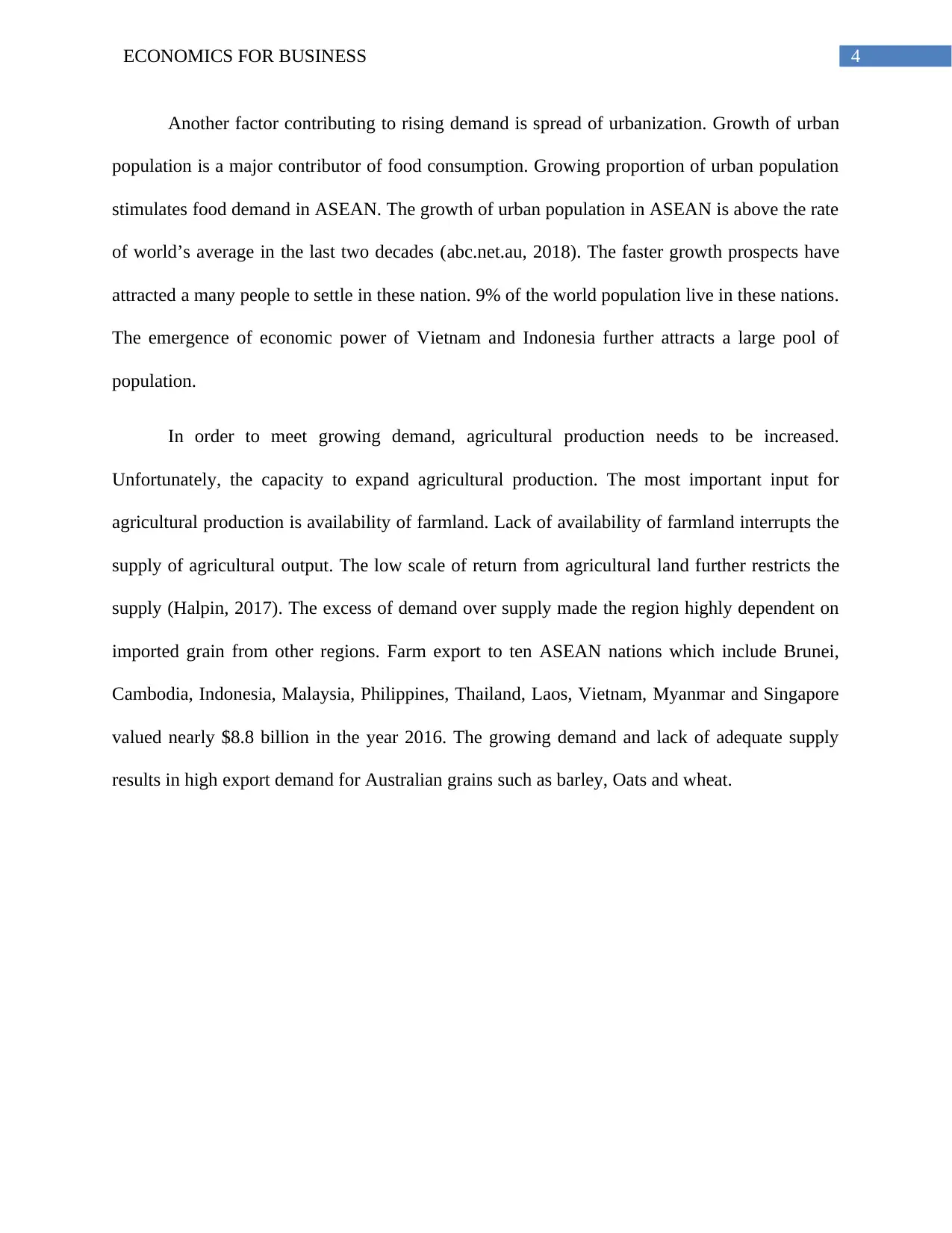
4ECONOMICS FOR BUSINESS
Another factor contributing to rising demand is spread of urbanization. Growth of urban
population is a major contributor of food consumption. Growing proportion of urban population
stimulates food demand in ASEAN. The growth of urban population in ASEAN is above the rate
of world’s average in the last two decades (abc.net.au, 2018). The faster growth prospects have
attracted a many people to settle in these nation. 9% of the world population live in these nations.
The emergence of economic power of Vietnam and Indonesia further attracts a large pool of
population.
In order to meet growing demand, agricultural production needs to be increased.
Unfortunately, the capacity to expand agricultural production. The most important input for
agricultural production is availability of farmland. Lack of availability of farmland interrupts the
supply of agricultural output. The low scale of return from agricultural land further restricts the
supply (Halpin, 2017). The excess of demand over supply made the region highly dependent on
imported grain from other regions. Farm export to ten ASEAN nations which include Brunei,
Cambodia, Indonesia, Malaysia, Philippines, Thailand, Laos, Vietnam, Myanmar and Singapore
valued nearly $8.8 billion in the year 2016. The growing demand and lack of adequate supply
results in high export demand for Australian grains such as barley, Oats and wheat.
Another factor contributing to rising demand is spread of urbanization. Growth of urban
population is a major contributor of food consumption. Growing proportion of urban population
stimulates food demand in ASEAN. The growth of urban population in ASEAN is above the rate
of world’s average in the last two decades (abc.net.au, 2018). The faster growth prospects have
attracted a many people to settle in these nation. 9% of the world population live in these nations.
The emergence of economic power of Vietnam and Indonesia further attracts a large pool of
population.
In order to meet growing demand, agricultural production needs to be increased.
Unfortunately, the capacity to expand agricultural production. The most important input for
agricultural production is availability of farmland. Lack of availability of farmland interrupts the
supply of agricultural output. The low scale of return from agricultural land further restricts the
supply (Halpin, 2017). The excess of demand over supply made the region highly dependent on
imported grain from other regions. Farm export to ten ASEAN nations which include Brunei,
Cambodia, Indonesia, Malaysia, Philippines, Thailand, Laos, Vietnam, Myanmar and Singapore
valued nearly $8.8 billion in the year 2016. The growing demand and lack of adequate supply
results in high export demand for Australian grains such as barley, Oats and wheat.
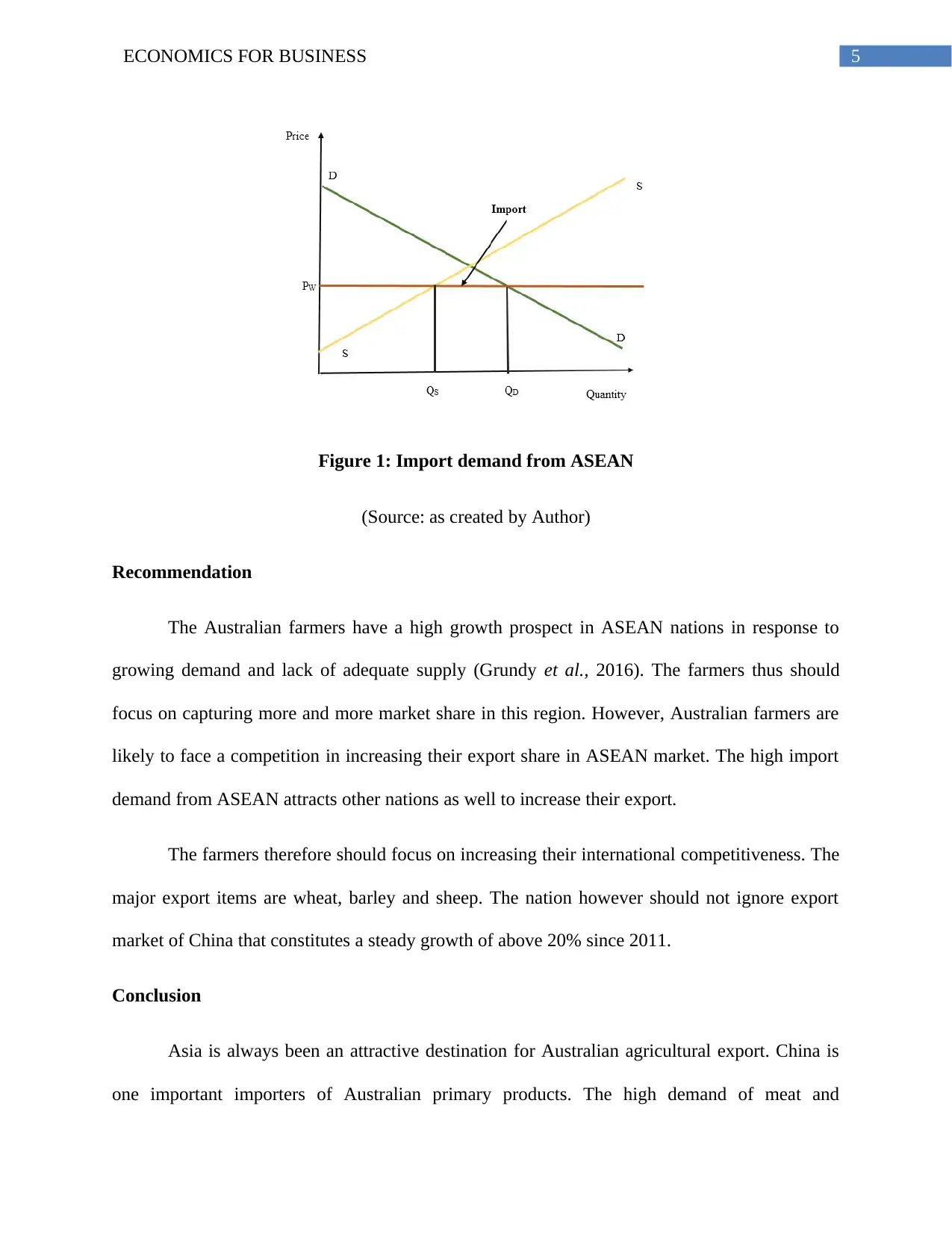
5ECONOMICS FOR BUSINESS
Figure 1: Import demand from ASEAN
(Source: as created by Author)
Recommendation
The Australian farmers have a high growth prospect in ASEAN nations in response to
growing demand and lack of adequate supply (Grundy et al., 2016). The farmers thus should
focus on capturing more and more market share in this region. However, Australian farmers are
likely to face a competition in increasing their export share in ASEAN market. The high import
demand from ASEAN attracts other nations as well to increase their export.
The farmers therefore should focus on increasing their international competitiveness. The
major export items are wheat, barley and sheep. The nation however should not ignore export
market of China that constitutes a steady growth of above 20% since 2011.
Conclusion
Asia is always been an attractive destination for Australian agricultural export. China is
one important importers of Australian primary products. The high demand of meat and
Figure 1: Import demand from ASEAN
(Source: as created by Author)
Recommendation
The Australian farmers have a high growth prospect in ASEAN nations in response to
growing demand and lack of adequate supply (Grundy et al., 2016). The farmers thus should
focus on capturing more and more market share in this region. However, Australian farmers are
likely to face a competition in increasing their export share in ASEAN market. The high import
demand from ASEAN attracts other nations as well to increase their export.
The farmers therefore should focus on increasing their international competitiveness. The
major export items are wheat, barley and sheep. The nation however should not ignore export
market of China that constitutes a steady growth of above 20% since 2011.
Conclusion
Asia is always been an attractive destination for Australian agricultural export. China is
one important importers of Australian primary products. The high demand of meat and
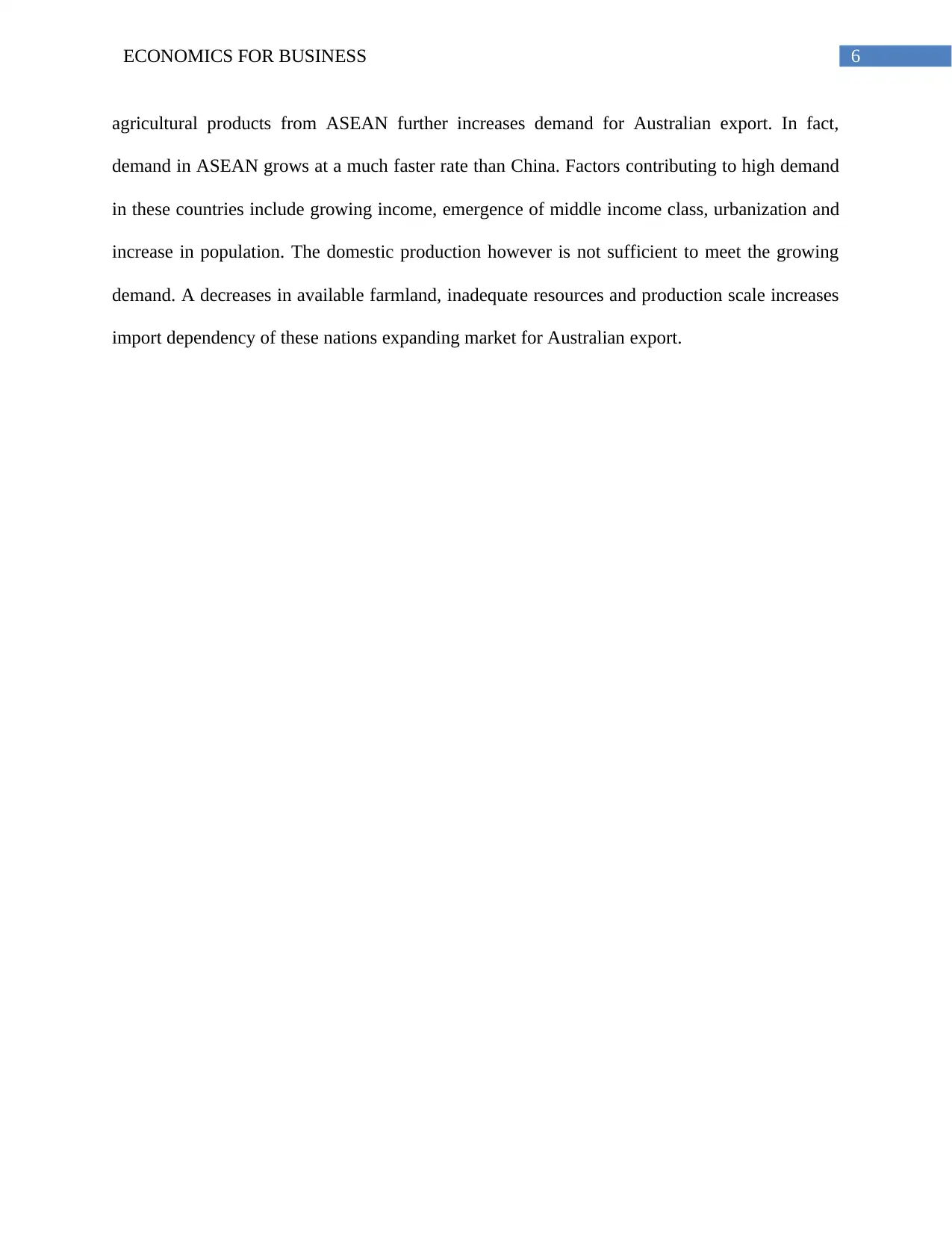
6ECONOMICS FOR BUSINESS
agricultural products from ASEAN further increases demand for Australian export. In fact,
demand in ASEAN grows at a much faster rate than China. Factors contributing to high demand
in these countries include growing income, emergence of middle income class, urbanization and
increase in population. The domestic production however is not sufficient to meet the growing
demand. A decreases in available farmland, inadequate resources and production scale increases
import dependency of these nations expanding market for Australian export.
agricultural products from ASEAN further increases demand for Australian export. In fact,
demand in ASEAN grows at a much faster rate than China. Factors contributing to high demand
in these countries include growing income, emergence of middle income class, urbanization and
increase in population. The domestic production however is not sufficient to meet the growing
demand. A decreases in available farmland, inadequate resources and production scale increases
import dependency of these nations expanding market for Australian export.
Paraphrase This Document
Need a fresh take? Get an instant paraphrase of this document with our AI Paraphraser
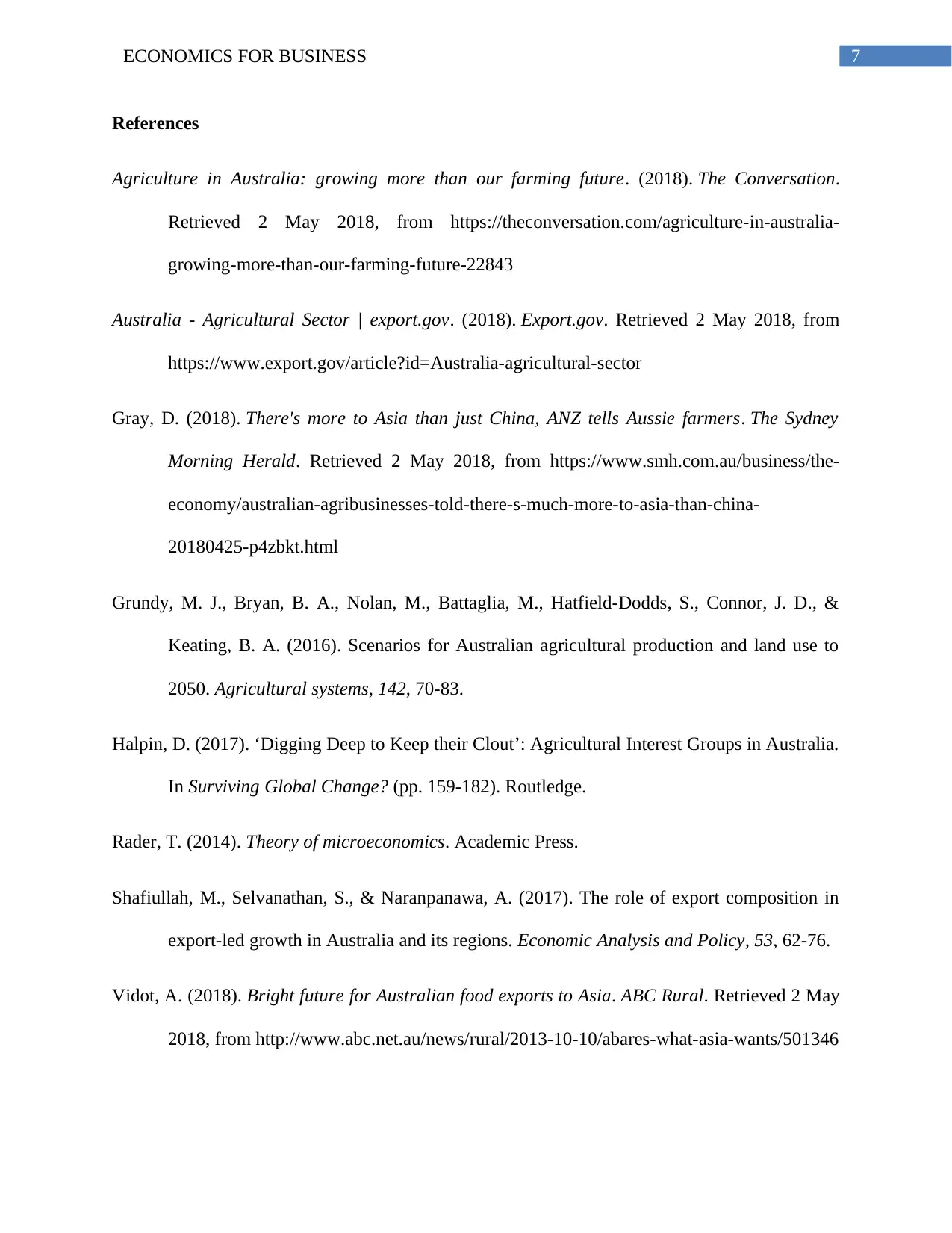
7ECONOMICS FOR BUSINESS
References
Agriculture in Australia: growing more than our farming future. (2018). The Conversation.
Retrieved 2 May 2018, from https://theconversation.com/agriculture-in-australia-
growing-more-than-our-farming-future-22843
Australia - Agricultural Sector | export.gov. (2018). Export.gov. Retrieved 2 May 2018, from
https://www.export.gov/article?id=Australia-agricultural-sector
Gray, D. (2018). There's more to Asia than just China, ANZ tells Aussie farmers. The Sydney
Morning Herald. Retrieved 2 May 2018, from https://www.smh.com.au/business/the-
economy/australian-agribusinesses-told-there-s-much-more-to-asia-than-china-
20180425-p4zbkt.html
Grundy, M. J., Bryan, B. A., Nolan, M., Battaglia, M., Hatfield-Dodds, S., Connor, J. D., &
Keating, B. A. (2016). Scenarios for Australian agricultural production and land use to
2050. Agricultural systems, 142, 70-83.
Halpin, D. (2017). ‘Digging Deep to Keep their Clout’: Agricultural Interest Groups in Australia.
In Surviving Global Change? (pp. 159-182). Routledge.
Rader, T. (2014). Theory of microeconomics. Academic Press.
Shafiullah, M., Selvanathan, S., & Naranpanawa, A. (2017). The role of export composition in
export-led growth in Australia and its regions. Economic Analysis and Policy, 53, 62-76.
Vidot, A. (2018). Bright future for Australian food exports to Asia. ABC Rural. Retrieved 2 May
2018, from http://www.abc.net.au/news/rural/2013-10-10/abares-what-asia-wants/501346
References
Agriculture in Australia: growing more than our farming future. (2018). The Conversation.
Retrieved 2 May 2018, from https://theconversation.com/agriculture-in-australia-
growing-more-than-our-farming-future-22843
Australia - Agricultural Sector | export.gov. (2018). Export.gov. Retrieved 2 May 2018, from
https://www.export.gov/article?id=Australia-agricultural-sector
Gray, D. (2018). There's more to Asia than just China, ANZ tells Aussie farmers. The Sydney
Morning Herald. Retrieved 2 May 2018, from https://www.smh.com.au/business/the-
economy/australian-agribusinesses-told-there-s-much-more-to-asia-than-china-
20180425-p4zbkt.html
Grundy, M. J., Bryan, B. A., Nolan, M., Battaglia, M., Hatfield-Dodds, S., Connor, J. D., &
Keating, B. A. (2016). Scenarios for Australian agricultural production and land use to
2050. Agricultural systems, 142, 70-83.
Halpin, D. (2017). ‘Digging Deep to Keep their Clout’: Agricultural Interest Groups in Australia.
In Surviving Global Change? (pp. 159-182). Routledge.
Rader, T. (2014). Theory of microeconomics. Academic Press.
Shafiullah, M., Selvanathan, S., & Naranpanawa, A. (2017). The role of export composition in
export-led growth in Australia and its regions. Economic Analysis and Policy, 53, 62-76.
Vidot, A. (2018). Bright future for Australian food exports to Asia. ABC Rural. Retrieved 2 May
2018, from http://www.abc.net.au/news/rural/2013-10-10/abares-what-asia-wants/501346
1 out of 8
Related Documents
Your All-in-One AI-Powered Toolkit for Academic Success.
+13062052269
info@desklib.com
Available 24*7 on WhatsApp / Email
![[object Object]](/_next/static/media/star-bottom.7253800d.svg)
Unlock your academic potential
© 2024 | Zucol Services PVT LTD | All rights reserved.





